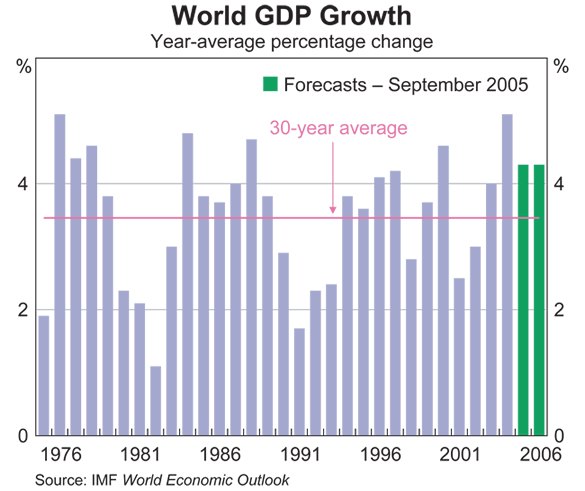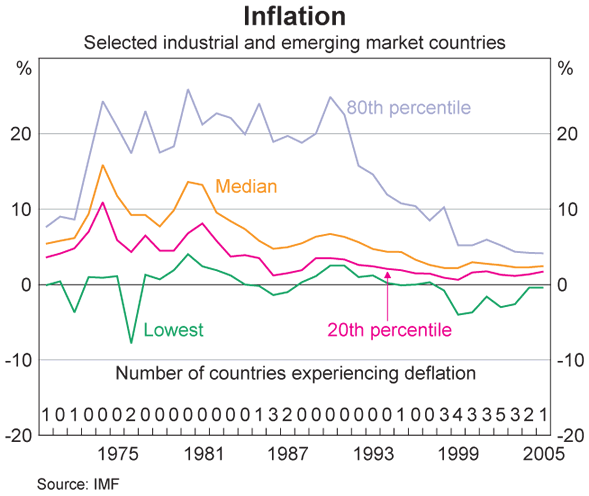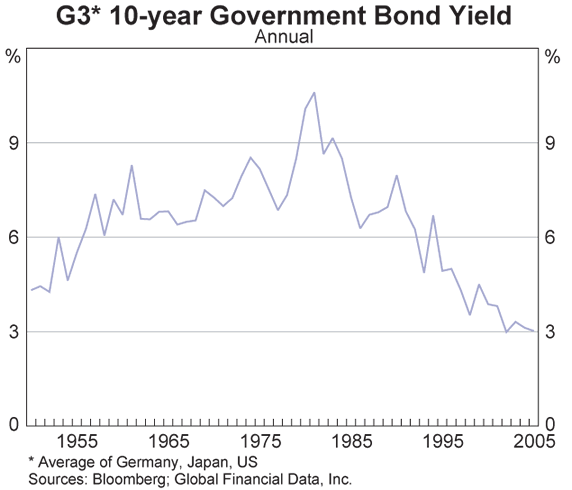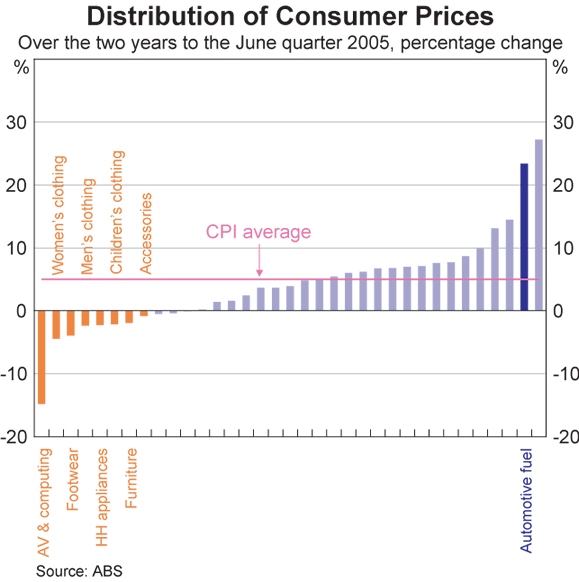Bulletin – October 2005 Economic Conditions and Prospects: October 2005
Address by Mr GR Stevens, Deputy Governor, to the Tasmanian Chamber of Commerce and Industry Business Dinner, Hobart, 11 October 2005.
It is nice to be in Hobart and I thank the Tasmanian Chamber of Commerce and Industry for the invitation. It is now a couple of months since the Bank released its most recent quarterly assessment of economic conditions, at which time some of our staff paid one of their regular visits to Tasmania to consult with local businesses.
So I intend to offer a brief instalment in the unfolding narrative of the economy, with the benefit of an extra couple of months' information. Of course, a few weeks from now we will release our next full Statement on Monetary Policy. I won't try to preview that in detail, but rather pick on one or two issues of note. I'll begin with the world economy.
The World Economy
The year 2005 is turning out to be another pretty good one for global growth. In its recent World Economic Outlook released during late September, the IMF estimates growth in 2005 to be about 4¼ per cent (Graph 1). That is lower than in the preceding year, but 2004 was exceptional: in that year, we saw the fastest global growth in three decades. At this point, 2006 is thought likely to be another good year, though that forecast would be sensitive to events in the next few months.

The US economy continues to expand at a good pace. The recovery from the dot-com-bust recession of 2001 has been quite strong, notwithstanding periodic talk about ‘soft patches’. The US now, once again, stands pretty close to full employment. The US central bank, having been prepared to lower short-term interest rates dramatically to alleviate the downturn, is now well advanced in the process of returning them to normal, as they must if the economic expansion is to continue for an extended period. Meanwhile, China has continued to grow rapidly, despite fears of a slump at various stages. Japan – for years a dragging anchor on global growth – has posted some better numbers over the past year or so, and the debilitating effects of asset price deflation and balance sheet deterioration may finally be starting to wane. Japan looks more likely to be able to sustain growth now than at any time in over a decade.
Elsewhere in east Asia, results are a bit mixed but in general show fairly healthy growth, though not at the pace seen for many years prior to the crisis of the late 1990s. The economy of continental Europe remains a major disappointment both for its own citizens and policy-makers, and for those elsewhere looking for the global recovery to be a bit more balanced. Beset by the effects of ageing, high levels of government debt and great difficulties in achieving structural reform, the old continental European economies are struggling to keep up with the newer, more dynamic countries joining the European project from the east.
At the same time, global rates of inflation remain low. Across about 50 significant countries around the world, the median inflation rate is about 2½ per cent (Graph 2). The scourge of the 1970s and early 1980s has been well and truly contained in most countries; there are relatively few really high-inflation countries now. At the same time, the incidence of de flation (never that wide) has diminished in the past couple of years.

There is, of course, the likelihood that the big rise in oil prices will push inflation up over the coming year, and some commentators are beginning to worry that this could be the start of an undesirable trend. Much will depend on how economies and policy-makers respond to the rise in oil prices, a subject to which I shall return shortly. For the moment, what is remarkable is that the rise in raw material prices over several years has not already pushed inflation rates up more than it has.
It is partly as a result of this general climate of price stability that nominal long-term market interest rates are at 50-year lows (Graph 3). But even in real terms, long rates are unusually low. Apparently, financial markets have a very benign view of the risks associated with the medium-term outlook.

Given the prominence of discussion about ‘global imbalances’ – by which people mean the dependence of the global expansion on the strength of the US and China, and the rising current account deficit of the US – it is all the more remarkable that financial markets seem so sanguine. But as stated by the Governor[1] a couple of weeks ago, a more careful analysis of the ‘imbalances’ shows that high rates of saving and low rates of investment in Asia have produced a very low cost of capital for the developed world, to which the US economy has responded, with the US current account deficit a natural result. While everyone agrees this cannot continue forever, forever is a long time and it may well continue for a while yet. It has already gone on much longer than many predicted would be possible, and for it to change, behaviour in Asia, as well as in the US, would need to alter.
All of the above have been part of the scene for some time now, and were part of the state of play as of early August when we last gave our full views. What has changed of late?
The questions that will naturally be on most people's minds are: what will be the effect on the US and global economies of Hurricanes Katrina and Rita? And what will be the effect of rising oil prices?
Hurricanes
Clearly these were first and foremost human tragedies on a massive scale, though thankfully, the death toll looks like it is turning out to be much smaller than was feared early on. As for the economic effects, clearly business activity has been hampered in the areas directly in the path of the hurricanes, though the impact of this on the US economy as a whole doesn't seem to have been particularly large. Longer term, those parts of the US capital stock which were damaged or destroyed need to be repaired or rebuilt. This will be expansionary as it adds to the demand for real resources. To give some perspective, estimates of damage seem to be around US$200 billion. If it took three years[2] to do all the reconstruction, then we would see an addition to the level of demand equivalent to about half of 1 per cent of US GDP during that period. This would be in an economy which, just before the hurricanes hit, was travelling pretty well according to recent data.
Energy prices
A second key aspect of the hurricanes, of course, was that they damaged some very important infrastructure in the US energy supply chain, which happens to be concentrated along the Gulf coast. To some extent this has been addressed by the release of oil from stockpiles, and indeed the price of crude oil is now, if anything, a bit lower than it was immediately before Hurricane Katrina. The bigger problem is that the Gulf coast area has a large share of US refining capacity, which also suffered substantial damage. Hence the margin between crude oil prices and wholesale prices for refined products rose sharply, so Americans (and, for that matter, consumers elsewhere) saw substantial rises in prices at the pump (Graph 4).

The effect of this, assuming other things equal, is to raise households' cost of living and transportation costs to businesses. Any number of commentators will remind us that, because it is hard for consumers rapidly to alter their behaviour away from using gasoline, they will, to some extent, simply have to pay the higher prices and spend less on other things. This imparts a mild contractionary impact on aggregate demand. That's true, but over time, consumers can adapt their behaviour (towards more fuel-efficient cars, for example) to lessen the real income loss. Most importantly in the US, the impact of the rebuilding will steadily make its presence felt. So there is a complex set of forces operating on the US economy, some contractionary but others expansionary.
For those other economies which are net energy importers, the expansionary impact of the rebuilding is of course absent, so they are left with the uncomfortable combination of higher prices and slower growth, at the margin, than would otherwise have occurred.
But it would be a serious mistake, I think, to focus on the effects of the hurricanes on energy prices in isolation. The fact is that energy prices had been rising for some time, as growing demand stretched supply capacity, before the hurricanes occurred. It is no secret, either, that Asia has been a major source of additional demand for oil (though demand in the US has also risen). Of the rise in global demand since 2000 of over 7 million barrels per day, about 3 million barrels has come from Asia, and almost 2 million from China alone. Nor is it only energy prices which have been rising. A great many prices of resource-type commodities have been rising quickly, largely for the same reason as oil prices: Asian and especially Chinese demand has stretched supply capacity.
Yet this has not derailed the global economic expansion. Unlike the OPEC oil shocks of the 1970s, when the supply of oil was sharply curtailed, creating significant disruption for economic activity, over the past few years the supply of oil has been increasing – just not fast enough to accommodate rapidly rising demand at the old, low price. Far from crippling global growth, the higher price of oil reflects strong growth. Higher oil prices do reduce growth compared with what might have been possible had the supply of oil been perfectly elastic, but even with that reduction, the world economy is recording quite good growth. One illustration of this is that, eighteen months ago, the IMF forecast of global growth for 2005 was 4.4 per cent, with oil prices assumed to be under US$30. The latest estimate for 2005 is virtually unchanged at 4.3 per cent (with the same again expected in 2006), but with an average oil price now assumed to be US$54 in 2005, and US$62 in 2006.
Monetary policy and oil prices
How should monetary policy, in particular, respond to rising energy prices?
Traditionally, policy-makers have abstracted from the effects of short-term fluctuations in oil prices. The case for doing so was that these swings are often driven by temporary supply-side disturbances. It would not make sense for monetary policy, whose effects take several years to play out, to respond to price fluctuations which might be reversed within a matter of months. Fluctuations in prices for some other things affected by supply disturbances – like fresh food – are treated the same way. It is for this reason that many central banks compute measures of ‘core’ or ‘underlying’ inflation – it helps us get a better idea how overall inflation will look when temporary disturbances have passed from the scene.
Similarly, in cases where there is a large, permanent but one-time change in the level of energy prices which occurs because of a change in supply, it is not feasible for monetary policy to offset the immediate impact on the overall price level. Policy-makers in that situation will focus on ensuring the on-going rate of change of prices settles back fairly promptly. This means they will typically respond to signs of second-round effects which might emerge if, say, other prices or wages began to change in response to the initial oil price effect.
But where there is a persistent trend for some particular price to rise quickly over a longish period because demand is strong, the case for ignoring that is weak. If oil prices, for example, rise quickly every year, it isn't really credible to abstract from them every year. Rather, the question is simply one of whether the combined set of all price movements, whether driven by energy prices or any other influence, will cause the CPI to rise quickly for an extended period. If the answer is yes, then that is called inflation, and is prima facie evidence that policy-makers should take action. If the answer is no, perhaps because non-energy prices are moving in an offsetting way, then price stability is being maintained, and there is no particular implication for policy.
In recent years, policy-makers in most countries seem generally, thus far, to have felt that rising oil prices will not threaten medium-term inflation performance. This was partly because there was always thought to be the possibility of some reversal in the oil price itself, but also because overall inflation rates in most countries have remained quite low so far, despite energy price rises. While the strong growth in energy demand in Asia for several years has contributed to inflationary pressure through higher prices for oil, Asia has also contributed to de flationary pressure via its growing role as a supplier of manufactures and, increasingly, services. The fact that the overall rate of inflation through this period has been fairly well behaved, despite strong global economic growth, is distinctly in contrast to the situation prior to the OPEC episode in 1974. In that instance, inflation in most countries was already increasing before the rise in oil prices occurred.
At issue, then, is whether that situation could change in the near future. It is doubtful that the hurricane-related shock per se would make a large difference. The bigger questions are, first, will the effects of the large cumulative rises in energy prices over several years continue to be accompanied by moderation in other prices, including international prices for traded manufactures and services, so keeping overall inflation in check? And second, will hitherto well-anchored inflation expectations – an important determinant of price and wage behaviour generally – remain that way?
Policy-makers around the world will grapple with these issues in the period ahead. For now, I shall turn to the Australian economy.
The Australian Economy
The terms of trade
The Australian economy, like all other industrial economies, is adjusting to higher energy prices. The thing we are hearing most about is the negative impact on Australian households as they bear higher costs for their personal transportation, and the effect on both the goods and services producing sectors of the economy as they bear another increase in costs of production and distribution. But unlike many industrialised economies, there is also a major positive side for the Australian economy in higher prices for energy and raw materials. For those with an income stake in the extraction of these resources – such as oil, coal, gas, and a number of other commodities which are inputs into global industrial production – times are very good indeed.
The aggregate summary of this situation is Australia's terms of trade, which have risen by over 20 per cent in the past two years alone, and stand about 30 per cent above their average of the period 1975–2000 (Graph 5).

This is a very different story to those of most industrialised economies, for which recent developments represent a decline in the terms of trade and hence national income (Table 1).
| Past 2 years | |
|---|---|
| Australia | 23.4 |
| Norway | 9.3 |
| New Zealand | 8.6 |
| Mexico | 8.5 |
| Canada | 4.2 |
| United Kingdom | 0.2 |
| France | −3.7 |
| Singapore | −4.8 |
| Germany | −5.0 |
| United States | −7.0 |
| Thailand | −9.5 |
| Taiwan | −12.6 |
| Sweden | −14.3 |
| Japan | −16.6 |
|
Sources: ABS; Thomson Financial |
|
The trade sector is just over one-fifth of the economy. So a 20–25 per cent gain equates to about 4–5 per cent of GDP – say, $40 billion – in additional annual income that is available. Part of that income accrues to foreign investors who have ownership stakes in resources enterprises, but a substantial proportion remains for Australians as shareholders, employees and citizens (via government taxes).
There can be little doubt that this adds considerable buoyancy to the economy which would not otherwise be there. The first-round effect is clearest in the regions where resources have the greatest weight in economic activity. But there are still impacts around the rest of the country – for example, through the consumption of higher resource-derived incomes, and higher investment by the resource producers. Indeed, the prospects now appear to be for a significant expansion in capacity in various resource production areas, judging by the forward-looking indicators of capital expenditure. That will continue to exert stimulus for a range of other businesses around the country.
Housing market
These income gains have accelerated over the past two years, at a time when the dynamics of the Australian housing market have changed. From 1996 to 2003, Australian households borrowed at a rapid pace for the purposes of owning dwellings, either to occupy or to let out. The median price of dwellings in Australia rose in parallel, by 120 to 150 per cent, depending on the price measure used.[3]
The peak in prices nationally was about two years ago now, in the last quarter of 2003. Since then, median prices have risen further in some regions, but have fallen a little in Sydney and Melbourne, to give a flat performance for the national median price. This has been associated with a slowing in the pace of borrowing, particularly on the part of investors, though the rate of growth of outstanding credit remains, if anything, somewhat higher than one would expect to be a sustainable pace in the long run.
This has been associated with a waning of an apparent wealth effect which had been in operation, where consumer spending rose faster than income for a number of years and household saving rates declined.[4] Some estimates suggest that, in net terms, households actually withdrew some of the accumulated equity in the dwelling stock during the early years of this decade, a small proportion of which was probably used for consumption purposes. (The rest appears to have been placed into financial assets.) But since mid 2004, consumption spending has been proceeding in a more moderate fashion. At 3 per cent growth over the past year, it has been rising more in line with income. That is not a particularly weak outcome in any absolute sense, but it is a quite notable slowing from the earlier 6 per cent pace.
It is quite fortuitous, of course, that this adjustment has coincided with the large income gains from the terms of trade. A scenario where the housing boom had gone on for two or three more years and then turned down at the same time as the terms of trade began a cyclical fall would have been much less attractive.
Petrol prices
I noted earlier that worldwide, rising energy prices over several years did not seem to have pushed up inflation much, so far, partly because there seemed to have been moderation in other prices. This same point can be nicely illustrated by Australia's Consumer Price Index. Graph 6 shows the change in the CPI, at the sub-group level,[5] over the past two years. The figures are up to June 2005; new data for the September quarter will be published the week after next.

Automotive fuel prices had risen by about 23 per cent over the period. But a number of items which are affected by strong international competition had fallen in price. These include most electronics categories, household appliances, clothing and footwear, and furniture. Of course, changes in the exchange rate, and in particular an appreciating A$ in 2003, have had an effect here, as have tariff reductions, but there is no doubt that competition from abroad has been intense. So while the growth in demand for energy in China and the rest of Asia has added to petrol costs, the rising production of manufactures in those countries has reduced other prices. The total CPI rise over the two years was 5 per cent, or 2½ per cent per year, which is exactly in line with the Bank's inflation target.
We will get an update to this picture when the CPI and PPI data for the September quarter are published. The direct impact of the recent high energy prices will presumably be evident in the result. Over a somewhat longer horizon, there might be some indirect impacts of the higher energy costs – through the transport system, for example. Just how big these turn out to be will presumably depend on, among other things, whether demand conditions allow businesses simply to pass on energy and transport cost increases, as opposed to absorbing them by finding offsetting cost savings or accepting narrower profit margins.
Longer term, the question to be asked is whether inflation – be it as a result of rises in energy costs, or from any other source – is likely to diverge persistently from a rate of 2–3 per cent. Apart from energy prices per se, factors to consider in assessing the outlook will be trends in international prices, the likelihood of temporarily higher CPI rises prompting second-round effects via, for example, higher wage claims or other cost increases, and the strength of aggregate demand in the economy. The Bank will publish its full updated assessment in its Statement on Monetary Policy on 7 November 2005.
Conclusion
The Australian economy is in its fifteenth year of expansion, having weathered a number of shocks, both favourable and adverse, during that time. The gradual correction of the housing excesses of the early part of this decade has gone well so far. It is our good fortune that this is unfolding alongside a global scene which is quite favourable at present. Even though there is undoubtedly a cyclical element to the international environment which will wane in time, I suspect that the growing weight of resource-hungry Asia will mean that our terms of trade will be higher on average in the next decade than they were in the last quarter of the twentieth century.
The issue before us in the next year or two is whether the world and Australian economies can adapt to higher energy and resource prices without a significant bout of inflation. If we can, then in a year or two from now, the TCCI will be hearing about further opportunities for businesses and their employees, both in Tasmania and around the nation, to create the sustainable prosperity we all seek.
Footnotes
‘What are the Global Imbalances?’
(see <http://www.rba.gov.au/speeches/2005/sp-gov-280905.html>).
[1]
In the case of Cyclone Tracy, which happened on 24–25 December 1974, Darwin's
pre-cyclone population numbers were able to be housed again by about the
middle of 1978
(see <http://www.ntlib.nt.gov.au/tracy>). Following Hurricane Andrew in August
1992, surveys suggest that about two-thirds of displaced residents had returned
to their homes by August 1994. Most of those who had not did not intend to
do so (see Smith SK and C McCarty (1996), ‘Demographic effects of natural
disasters: a case study of Hurricane Andrew’,
Demography, 33(2), pp 265–275).
[2]
In Tasmania, house prices rose by less over the same period though they have continued to rise of late. Tasmania still enjoys relatively lower costs of housing than the mainland. Not unrelated, I presume, is the trend in recent years for net interstate migration to, rather than from, Tasmania. [3]
Literally speaking, according to the national accounts, household spending on consumption has exceeded income for the past three years (i.e. saving was negative). This calculation includes an allowance for notional depreciation of the dwelling stock (which is treated as consumption of capital), but even in a gross sense, household saving, while positive, has been low. [4]
Here I separate automotive fuel from the transportation sub-group. [5]